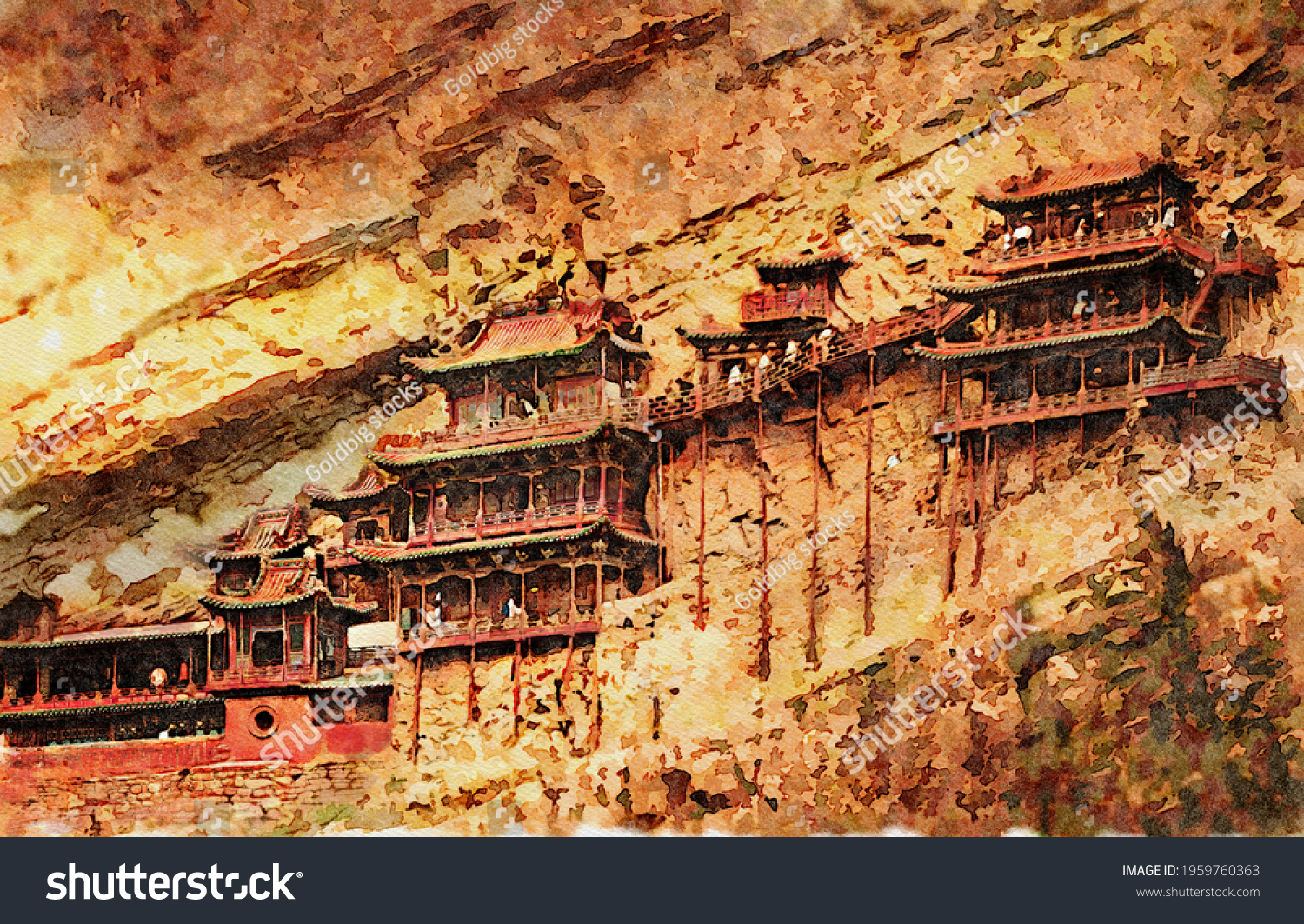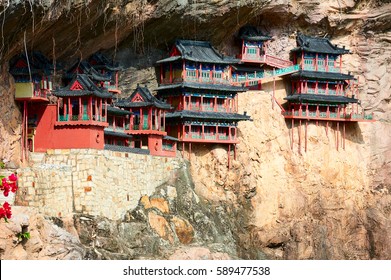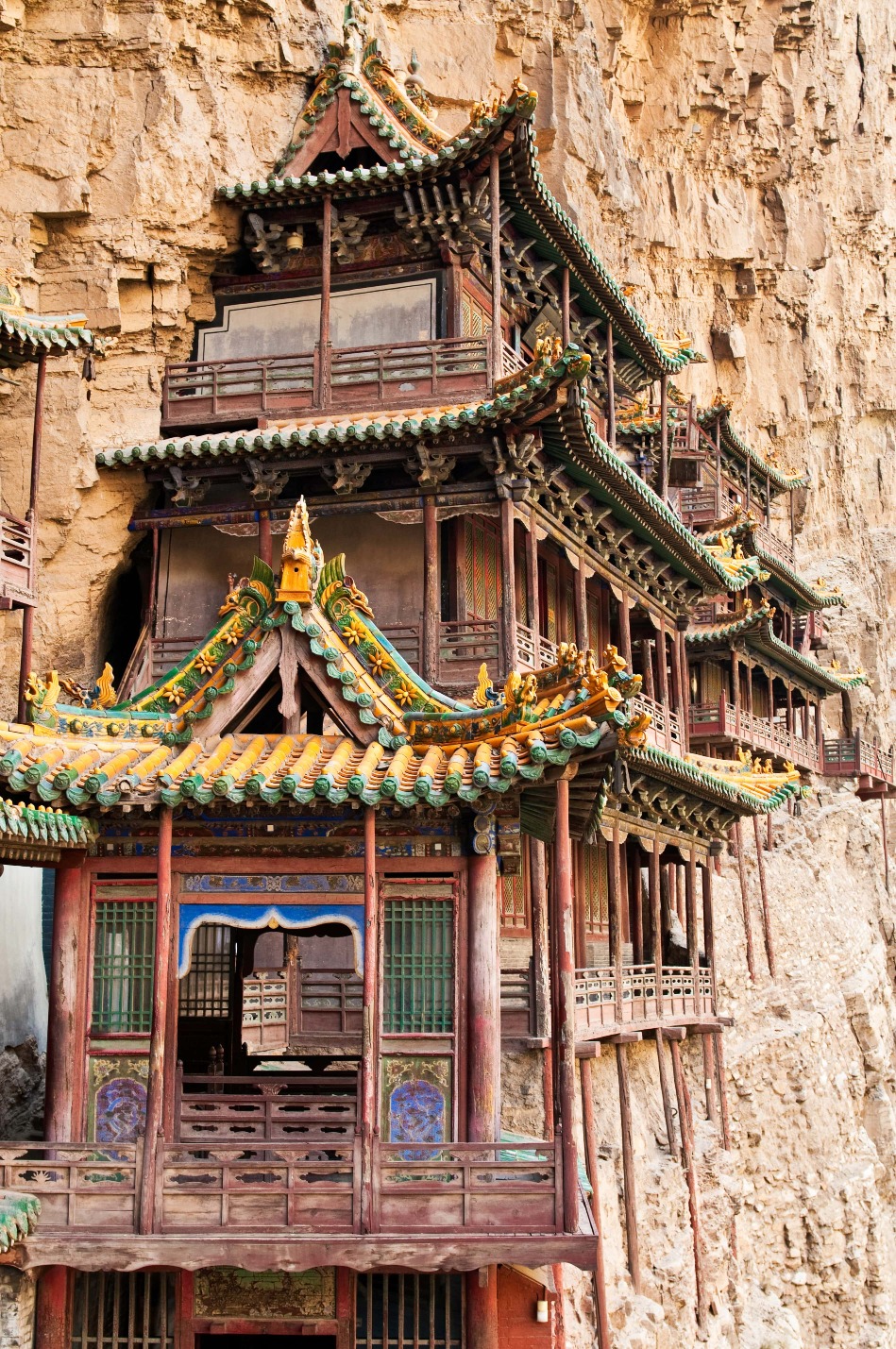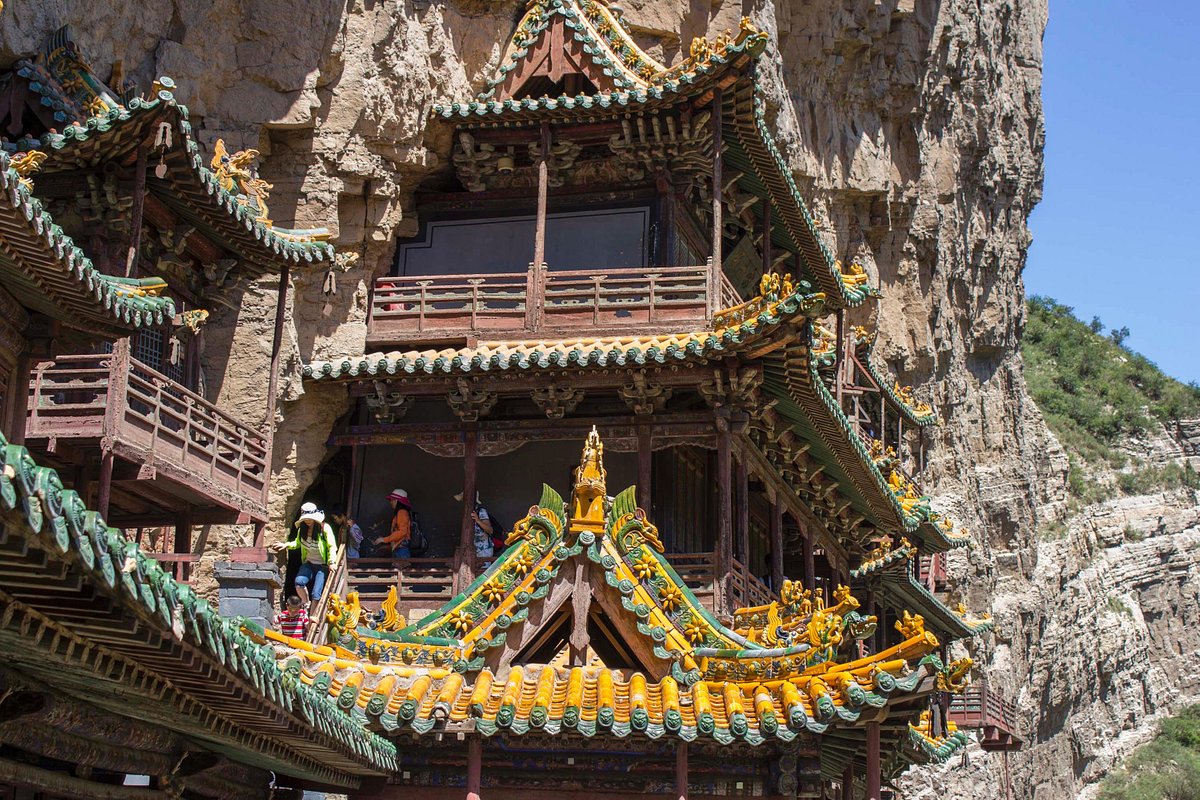7 Fascinating Facts About the Hanging Temple That Will Leave You in Awe
An Essential Guide to Visiting Hanging Temple
Nestled high upon the rugged cliffs of Mount Heng, the Hanging Temple (悬空寺, Xuánkōng Sì) is a breathtaking marvel that seems to defy gravity itself. Perched precariously over 50 meters above the valley floor, this extraordinary temple complex is a harmonious blend of Buddhism, Taoism, and Confucianism. With its wooden structures clinging to the cliffside, adorned with vibrant colors, it captivates visitors with both its stunning architecture and rich spiritual significance.
In this essential guide, we will take you on a journey through the history, architecture, and unique features of the Hanging Temple. You’ll discover practical tips for planning your visit, including the best times to explore, how to navigate ticketing, and the must-see highlights within the temple grounds. From the ingenious construction techniques that have allowed it to endure for over 1,500 years to the spiritual treasures housed within its halls, prepare to be inspired by one of China’s most iconic landmarks. Whether you’re a history enthusiast, an architectural aficionado, or simply in search of awe-inspiring views, the Hanging Temple promises an unforgettable experience that transcends the ordinary.
In This Guide
- An Essential Guide to Visiting Hanging Temple
- The Rich History and Legends of Hanging Temple
- Main Highlights: What You Absolutely Can’t Miss
- Planning Your Visit: A Practical Guide
- Tickets: Prices, Booking, and Tips
- How to Get There: A Complete Transportation Guide
- Local Cuisine and Accommodation Nearby
- Frequently Asked Questions
- Final Thoughts on Your Trip
The Rich History and Legends of Hanging Temple
A Journey Through Time: The Enigmatic History of the Hanging Temple
Ancient Beginnings: The Northern Wei Dynasty
The Hanging Temple, known in Mandarin as Xuánkōng Sì, was founded in 491 AD during the Northern Wei Dynasty, a period notable for its embrace of diverse religious practices. This beautiful structure was built to reflect the harmonious coexistence of Buddhism, Taoism, and Confucianism, making it not just a religious site but a symbol of unity among China’s major philosophical traditions. Its choice of location—perched on a cliffside in the Hengshan Mountain range—was both practical and spiritual, offering protection from floods and natural disasters while symbolizing the elevation of the soul towards the heavens.
A Testament to Engineering
The architectural ingenuity of the Hanging Temple is nothing short of remarkable. Constructed without nails, its wooden framework relies on a system of interlocking beams, a technique that has enabled it to withstand the test of time against earthquakes and erosion. The design is a brilliant blend of aesthetics and functionality, with narrow walkways connecting various halls, allowing visitors to experience the breathtaking views of the valley below. This engineering marvel serves as a reminder of the skill and craftsmanship of ancient builders, often compared to the legendary artisan Lu Ban for their exceptional talent.
Legends of Spiritual Significance
Throughout its long history, the Hanging Temple has been steeped in legends that highlight its spiritual importance. One prominent tale speaks of a monk who, after years of meditation, achieved enlightenment at this site and was said to have received visions that guided the temple’s construction. It is believed that the temple’s unique design was inspired by these divine revelations, allowing it to serve as a bridge between the earthly realm and the spiritual world.
Another popular legend involves the three main deities housed within the temple: Sakyamuni (the Buddha), Confucius, and Laozi. This rare assembly of figures from three different philosophies is said to symbolize the harmonious coexistence of their teachings, offering visitors a profound spiritual experience. The temple is often regarded as a pilgrimage site, drawing seekers of wisdom and enlightenment from all walks of life.
Trials and Triumphs: Preservation Through the Ages
As centuries passed, the Hanging Temple faced numerous challenges, including natural disasters and human neglect. In 2010, it was even designated as one of the top ten most endangered buildings by Time magazine, bringing global attention to its plight. However, significant restoration efforts have been made to preserve this architectural wonder, ensuring that it continues to stand as a testament to ancient Chinese ingenuity.
A Living Museum of Culture
Today, the Hanging Temple serves as a living museum, showcasing the rich tapestry of Chinese history and culture. Visitors can explore its intricate halls, adorned with vibrant sculptures and carvings that tell the stories of the deities honored within. The temple’s unique layout, with its various pavilions, offers a captivating glimpse into the spiritual traditions that have shaped Chinese society for over 1,500 years.
Conclusion: A Timeless Icon
The Hanging Temple is more than just an architectural marvel; it is a symbol of resilience, spirituality, and cultural harmony. Steeped in history and legends, it invites travelers to step into a world where the past and the present coalesce in breathtaking beauty. Whether you are an avid history enthusiast or a curious wanderer, the Hanging Temple promises an unforgettable journey through time, offering insights into the enduring spirit of human creativity and belief.

Hanging Temple.
Main Highlights: What You Absolutely Can’t Miss
Jaw-Dropping Cliffside Views
As you approach the Hanging Temple, your heart will race at the sight of its precarious perch over 50 meters above the valley floor. This stunning location, clinging to the rugged cliffs of Mount Heng, offers breathtaking panoramic views that stretch for miles. Make sure to capture this awe-inspiring scene with your camera; the contrast of the temple’s vibrant reds and greens against the gray rock is simply mesmerizing. Tip: Arrive early in the morning or late afternoon for the best lighting and fewer crowds.
Three Religions Hall
Step into the Three Religions Hall, a unique space that houses statues of Sakyamuni, Confucius, and Laozi. This is one of the rare instances in China where these three influential figures are honored together, symbolizing the harmonious coexistence of Buddhism, Taoism, and Confucianism. The intricate details of the statues and the hall’s serene atmosphere make this a spiritual highlight of your visit. Tip: Take a moment here to reflect and soak in the harmonious energy of this sacred space.
Aerial Walkway Adventure
Don’t miss the thrilling aerial walkway that connects the south and north pavilions. This wooden pathway, resting on a stone base, allows you to experience the temple’s “hanging” design up close. As you walk along, look up to admire the ancient carvings of the three Buddhas—Dharmakaya, Sambhogakaya, and Nirmanakaya—some of the oldest sculptures in the temple. Tip: Hold onto the railing and take your time; the views are breathtaking, and you’ll want to capture every angle!
Mahavira Hall Treasures
The Mahavira Hall is a treasure trove of history, showcasing three magnificent statues from the Ming Dynasty. Crafted using a special dry lacquer technique, these statues are celebrated for their exquisite detail and artistry. Standing here, you’ll feel a direct connection to the rich artistic heritage of China. Tip: Spend a few moments in this hall to appreciate the craftsmanship and take a closer look at the fine details that tell stories of the past.
Lotus-Patterned Stairs
As you navigate the temple, pay special attention to the beautifully crafted wooden stairs adorned with lotus patterns. These designs symbolize auspiciousness and the spiritual journey towards enlightenment. Each step you take resonates with meaning, making your ascent even more special. Tip: Capture a close-up photo of the lotus patterns to remember the intricate artistry that reflects the temple’s spiritual essence.
Thunder Sound Hall
At the highest point of the temple, the Thunder Sound Hall awaits you. Inside, you’ll discover impressive clay sculptures and reliefs that depict Sakyamuni. This hall is not only a visual delight but also serves as a contemplative space dedicated to one of Buddhism’s most revered figures. Tip: Listen carefully; the acoustics in the hall create a unique ambiance that enhances the spiritual experience.
Historic Stele and Stories
Before you leave, don’t forget to check out the historic stele embedded in the south wall of the temple’s gate. Titled “Record of the Reconstruction of the Hanging Temple Gate,” this inscription offers fascinating insights into the temple’s history and the efforts taken to preserve this architectural marvel. Tip: Take a moment to read the stele and appreciate the dedication of those who worked to keep this piece of history alive for generations to come.
Each of these highlights at the Hanging Temple tells a story of architectural brilliance, spiritual significance, and cultural harmony. Make sure to take your time exploring these captivating features as you immerse yourself in this extraordinary experience.

Hanging Temple.
Planning Your Visit: A Practical Guide
Best Time to Visit
The optimal period for exploring the Hanging Temple is between May and October. During these months, the weather in Shanxi Province is warm and comfortable, perfect for outdoor activities. Spring and autumn offer particularly stunning scenery, with vibrant colors enhancing the natural beauty surrounding the temple.
- Spring (April – June): Enjoy blooming flowers and mild temperatures, ideal for sightseeing.
- Autumn (September – November): Experience cooler weather and breathtaking fall foliage, perfect for photography.
Recommended Itinerary
When planning your visit, consider a 2-3 hour itinerary, allowing ample time to explore the temple’s unique architecture and spiritual ambiance. Here’s a suggested schedule:
- 8:00 AM – Arrival: Aim to arrive early to experience the temple before the crowds.
- 8:15 AM – Explore the Grounds: Take a leisurely walk around the temple area, capturing the stunning views from different angles.
- 8:30 AM – Enter the Temple: Visit various halls, including the Three Religions Hall and the Mahavira Hall, to admire the remarkable statues and architecture.
- 10:30 AM – Aerial Walkway Adventure: Don’t miss the thrilling aerial walkway linking the south and north pavilions for unique perspectives of the temple.
- 11:30 AM – Photography Session: Find the best spots for capturing the temple’s beauty against the backdrop of Hengshan Mountain.
Photography Tips
To capture the Hanging Temple in all its glory, keep these tips in mind:
- Early Morning Light: Arrive at 8:00 AM for the best natural lighting, which enhances the temple’s vibrant colors.
- Wide-Angle Lens: Use a wide-angle lens to capture the full scale of the temple and its dramatic location.
- Vary Your Angles: Explore different viewpoints around the temple to find unique compositions, especially from the walkways.
- Include People: Capture the essence of the temple by including visitors in your shots to showcase its scale and beauty.
- Golden Hour: If possible, stay until sunset, as the soft light creates stunning photographs of the temple against the evening sky.
What to Wear
Comfort is key when visiting the Hanging Temple, given its mountainous location and the need for some walking:
- Footwear: Wear sturdy walking shoes or hiking boots for stability on the walkways and stairs.
- Clothing: Dress in light layers, as temperatures can vary throughout the day.
- Accessories: Bring a hat and sunglasses for sun protection, especially if visiting during warmer months.
- Rain Gear: Consider packing a light rain jacket if you visit during the rainy season.
Insider Tips
-
Book Tickets in Advance: Reserve your temple entry ticket at least two days ahead to secure your spot, as only a limited number of visitors are allowed each day.
-
Local Cuisine: After your visit, indulge in the local Shanxi cuisine at nearby restaurants. Don’t miss trying the famous Shanxi vinegar and hand-pulled noodles.
-
Explore Nearby Attractions: If time allows, consider visiting other nearby sites such as the Yungang Grottoes or Datong City Wall to enrich your travel experience.
-
Guided Tours: For deeper insights into the temple’s history and significance, consider joining a guided tour. Knowledgeable guides can provide valuable context that enhances your visit.
-
Stay Hydrated: Bring a reusable water bottle to stay hydrated, especially if you plan to explore the area extensively.
With careful planning and these tips, your visit to the Hanging Temple will be an unforgettable adventure filled with awe-inspiring sights and rich cultural experiences!

Hanging Temple.
Tickets: Prices, Booking, and Tips
Visiting the Hanging Temple is an unforgettable experience, but securing your entrance can be just as thrilling as the adventure itself! Here’s everything you need to know about ticket prices, booking methods, and some handy tips to ensure you don’t miss out on this architectural marvel.
Ticket Information
| Ticket Type | Price (CNY) | Includes |
|---|---|---|
| Entrance Ticket | 15 | Access to the scenic area for a distant view of the Hanging Temple. |
| Temple Entry Ticket | 100 | Access to the temple, including all halls and exhibits. Limited daily entry. |
Booking Details
- Advance Booking: It is highly recommended to book your Temple Entry Ticket in advance, as only a limited number of visitors are allowed each day. Tickets for the Temple Entry can be reserved up to two days in advance, with sales starting at 7:30 AM daily.
- On-the-Spot Purchases: If you miss out on online booking, don’t fret! There are 80 tickets available for last-minute purchases at the entrance each day. Arrive early for the best chance to snag one of these coveted spots.
- Entrance Ticket: You can buy the Entrance Ticket both in advance and on the spot, making it a flexible option for those looking to take in the views without entering the temple itself.
Tips for Booking and Visiting
-
Plan Ahead: Given the limited entry for the Temple Entry, it’s wise to book your tickets as early as possible—especially during peak tourist seasons from May to October.
-
Timing Your Visit: To avoid the crowds and enjoy the best lighting for photographs, aim to arrive right when the gates open at 8:00 AM. Alternatively, consider visiting around noon or 4:00 PM for a quieter experience.
-
Holiday Considerations: Be mindful that national holidays can lead to larger crowds. Arriving early is crucial during these busy times to circumvent long lines.
-
Weather Prep: If you’re visiting between May and October, the weather is typically warm and pleasant. Don’t forget to bring sunscreen, sunglasses, and a hat to stay comfortable as you explore this breathtaking site.
With these tips and details at your fingertips, you’re well on your way to experiencing the Hanging Temple’s wonders. Happy travels!
How to Get There: A Complete Transportation Guide
Getting to the Hanging Temple: A Comprehensive Transportation Guide
Visiting the Hanging Temple, an architectural marvel suspended on the cliffs of Mount Heng, is an unforgettable experience. Here’s how to reach this breathtaking site from the nearest major city, Datong, and navigate the scenic area.
From the Nearest Major City: Datong
By Train:
Traveling by train is one of the most efficient ways to get from Datong to the Hanging Temple. Here’s how:
- Train to Hunyuan:
- Duration: Approximately 35-45 minutes
- Cost: Around 20-30 RMB ($3-5 USD)
-
Departure: Trains run frequently throughout the day, so you can easily find a time that suits your schedule.
-
From Hunyuan Station to Hanging Temple:
- Taxi or Rideshare: The distance from Hunyuan Station to the Hanging Temple is about 20 km (12 miles).
- Duration: Approximately 30 minutes by taxi.
- Cost: Expect to pay around 60-80 RMB ($9-12 USD).
By Bus:
Buses are a budget-friendly option to reach the Hanging Temple from Datong.
- Direct Bus from Datong:
- Departure Point: Datong’s Long-distance Bus Station.
- Duration: Approximately 1.5-2 hours.
- Cost: Around 30 RMB ($5 USD).
-
Frequency: Buses run every 30 minutes, especially during peak tourist season.
-
Arrival: Buses will drop you off at the entrance of the scenic area, making it easy to access the temple.
By Car:
If you prefer flexibility, renting a car or hiring a driver is a great choice.
- Driving Distance: About 65 km (40 miles) from Datong.
- Duration: Approximately 1.5 hours, depending on traffic.
- Rental Costs: Car rentals in Datong typically start at around 200 RMB ($30 USD) per day, not including fuel and insurance.
Getting Around the Scenic Area
Once you’ve arrived at the Hanging Temple, navigating the scenic area is straightforward:
-
Walking: The main pathways leading to the Hanging Temple are well-marked and designed for pedestrians. Expect a short hike with some steep sections, but the views make it worthwhile. Allocate about 20-30 minutes to walk from the main entrance to the temple.
-
Shuttle Buses: During peak seasons, shuttle buses may be available to transport visitors between different points within the scenic area. Keep an eye out for signs indicating shuttle stops.
-
Local Guides: If you wish to enhance your visit, consider hiring a local guide at the entrance. They can provide valuable insights into the history and architecture of the temple, enriching your experience.
Final Tips
-
Plan Ahead: The best time to visit is between May and October, when the weather is mild and ideal for outdoor activities. Arrive early to avoid crowds and enjoy the temple in peaceful surroundings.
-
Tickets: Don’t forget to purchase your entrance tickets in advance, especially if you plan to enter the temple itself, as space is limited.
With this transportation guide, you’re all set to embark on an adventure to the Hanging Temple! Enjoy the journey and soak in the incredible views along the way.

Hanging Temple.
Local Cuisine and Accommodation Nearby
Exploring the breathtaking Hanging Temple is sure to work up an appetite, and the surrounding area offers a delightful array of local cuisine that reflects the rich flavors of Shanxi Province. After a day of marveling at this architectural wonder, you’ll be eager to indulge in some regional specialties.
Local Delicacies to Savor
-
Shanxi Noodles (刀削面): This iconic dish features hand-sliced noodles that are chewy and perfect for soaking up flavorful broths or stir-fries. Often served with rich sauces, vegetables, and sometimes meat, these noodles are a must-try for any visitor.
-
Pingyao Beef (平遥牛肉): Originating from the nearby ancient city of Pingyao, this dish consists of tender slices of beef that are marinated and then slow-cooked to perfection. The meat is typically seasoned with spices and served cold, making it a refreshing option, especially during warm months.
-
Vinegar from Shanxi (山西老陈醋): Known as one of the best vinegars in China, this dark, aromatic vinegar is a staple in many local dishes. It’s often used as a dipping sauce or dressing, enhancing the flavors of dumplings and cold appetizers. Don’t miss the chance to taste it in various forms!
-
Stuffed Buns (包子): Locally known as “baozi,” these fluffy steamed buns are filled with a variety of ingredients, from savory meats to vegetables. Each bite is a comforting taste of home-cooked goodness, perfect for a quick snack after exploring the temple.
Accommodation Options Nearby
Whether you prefer a luxurious retreat or a cozy budget stay, there are plenty of accommodations near the Hanging Temple to suit your needs.
-
Luxury Option: Hengshan International Hotel
Located about 30 minutes from the Hanging Temple, this upscale hotel offers stunning views of the surrounding mountains. With elegant rooms, a spa, and fine dining options, it’s perfect for those looking to indulge in comfort and luxury after a day of exploration. -
Boutique Option: The Temple Retreat
Just a short drive from the Hanging Temple, this charming boutique hotel combines traditional Chinese architecture with modern amenities. Each room is uniquely decorated, offering a cozy and inviting atmosphere. The hotel also features a restaurant serving local dishes, allowing you to enjoy Shanxi flavors right at your doorstep. -
Budget Option: Datong Youth Hostel
For those traveling on a budget, the Datong Youth Hostel provides a friendly and welcoming environment. Located in Datong, about an hour’s drive from the temple, this hostel offers dormitory-style rooms and private accommodations at affordable rates. It’s an excellent option for backpackers and travelers seeking camaraderie.
With a variety of delicious local dishes to try and comfortable accommodations to choose from, your visit to the Hanging Temple will be filled with both culinary adventures and restful nights. Pack your bags and prepare for an unforgettable experience!

Hanging Temple.
Frequently Asked Questions
Frequently Asked Questions
1. Is the Hanging Temple suitable for children and the elderly?
Yes, the Hanging Temple can be visited by families with children and elderly travelers, but some caution is advised. The temple features narrow walkways and steep stairs, which may be challenging for those with mobility issues. It’s best to assess individual comfort levels before visiting.
2. Are there English signs and guides available?
Yes, the Hanging Temple has English signage throughout the site to help international visitors navigate. Additionally, guided tours in English are available that provide insights into the temple’s history and architecture, making it easier to understand its significance.
3. How much time should I plan for my visit?
Plan to spend about 2-3 hours exploring the Hanging Temple. This allows ample time to enjoy the stunning views, take photographs, and appreciate the intricate details of the temple’s architecture and artwork.
4. What are the opening hours of the Hanging Temple?
The temple is open from 8:00 AM to 6:00 PM. However, it’s best to arrive early to avoid crowds and enjoy the best lighting for photography.
5. How can I get to the Hanging Temple from Datong?
The Hanging Temple is located approximately 56 kilometers (about 35 miles) from Datong. You can reach it by taking a bus, hiring a taxi, or joining a guided tour. The journey typically takes around 1 to 1.5 hours, depending on traffic.
6. What is the ticket price for entering the Hanging Temple?
The entrance ticket to the Hanging Temple costs 100 RMB (approximately $16 USD). It’s advisable to book your ticket in advance, as there is a limit on the number of visitors allowed inside the temple each day.
7. What is the best time of year to visit the Hanging Temple?
The ideal time to visit is between May and October, when the weather is warm and pleasant. This season provides perfect conditions for outdoor exploration and stunning scenery, making your visit even more enjoyable.
8. Are there any facilities available for visitors?
Yes, there are basic facilities such as restrooms and small shops near the entrance where you can purchase snacks and drinks. However, it’s a good idea to bring your own water and snacks, especially if you plan to spend a few hours at the site.
Final Thoughts on Your Trip
As you reflect on your visit to the Hanging Temple, allow the awe of its grandeur and history to linger in your memory. This extraordinary site, suspended in the air and nestled against the rugged cliffs of Mount Heng, is not just an architectural marvel; it’s a testament to the enduring spirit of human creativity and faith. The harmonious blend of Buddhism, Taoism, and Confucianism encapsulates the rich tapestry of Chinese culture, inviting you to appreciate the beauty of diversity and unity.
Every step through the temple reveals intricate carvings, vibrant colors, and a breathtaking panorama of the surrounding mountains, creating a sensory experience unlike any other. As you journey back from this enchanting place, carry with you not just photographs, but a deeper understanding of the resilience of both nature and humankind.
So, whether you find yourself sharing tales of your adventure around the dinner table or simply reflecting quietly in your own space, remember that the Hanging Temple isn’t just a destination—it’s a reminder of the heights we can reach when we dare to dream and create. Embrace the spirit of exploration, and may your travels continue to inspire and enlighten you. Safe journeys ahead!